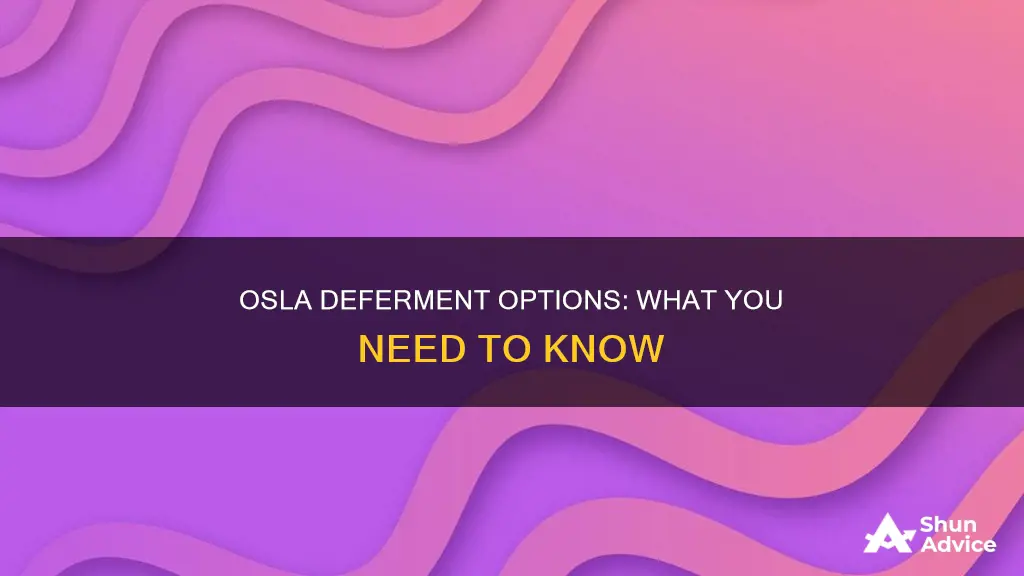
The Oklahoma Student Loan Authority (OSLA) was a federal student loan servicer that offered borrowers the option to defer their loans in certain circumstances. OSLA's contract expired in December 2024, and its borrowers have been transferred to another servicer called Aidvantage. However, OSLA previously provided various deferment options, including economic hardship deferment, unemployment deferment, and temporary hardship forbearance. Deferment allowed borrowers to postpone monthly principal and interest payments on specific loans, such as Stafford, PLUS, or Grad PLUS loans.
| Characteristics | Values |
|---|---|
| Deferment | A borrower may postpone monthly principal and interest payments on a Stafford, PLUS, or Grad PLUS loan. |
| Economic Hardship Deferment | A 12-month postponement of payments if receiving government or state assistance, or working full-time and meeting income requirements |
| Unemployment Deferment | A 6-month postponement of payments if unemployed, with potential interest subsidies |
| Temporary Hardship Forbearance | A short-term option to postpone payments or make interest-only payments |
| National Disaster Forbearance | Postpone payments for up to 90 days, which can be extended in 30-day increments upon request |
| Income-Driven Repayment | Qualified borrowers can base their monthly payments on their income and family size, subject to annual recertification |
| PLUS In-School Deferment | For dependent students enrolled at least half-time at an eligible institution, with a PLUS loan borrowed between July 1, 1987, and June 30, 2008 |
| Military Deferment | Deferment for up to 3 years for active-duty service members or National Guard members during a military operation, war, or national emergency |
What You'll Learn

Economic hardship deferment
The Oklahoma Student Loan Authority (OSLA) offers a 12-month postponement of payments under Economic Hardship Deferment. This option is available to those receiving any form of government or state assistance (WIC, Food Stamps, Medicaid, Supplemental Security Income (SSI), or Disability). It is also available to those working full-time who meet the income requirements for their family size. To qualify for this deferment, some documentation of hardship is usually required, and there is no interest accrued during the deferment period.
OSLA also offers an Unemployment Deferment, which allows eligible individuals to defer all payments for six months, sometimes with interest subsidies. For those facing temporary hardship, there is also a Temporary Hardship Forbearance option, which allows borrowers to postpone payments or make interest-only payments. Any unpaid interest will be capitalized and added to the principal balance at the end of the forbearance period.
Additionally, OSLA provides assistance to borrowers with FFELP loans, which do not qualify for CARES Act relief. This includes options such as National Disaster Forbearance, which allows for payment postponement for up to 90 days, with possible extensions in 30-day increments. Income-Driven Repayment is another option, which bases monthly payments on income and family size, subject to annual recertification.
It is important to note that as of December 31, 2024, OSLA has transferred the customer service of Federal Family Education Loans (FFEL) and Private Shelf Loans to The Higher Education Servicing Corporation (HESC). Borrowers can contact HESC for assistance with their student loan accounts.
Title Loans in Ohio: What You Need to Know
You may want to see also

Unemployment deferment
Deferment is a period of time during which a borrower may postpone monthly principal and interest payments on a loan. OSLA offers deferment options for borrowers facing unemployment. To qualify for unemployment deferment, borrowers must meet certain criteria. They must be seeking full-time employment in any field, at any salary or responsibility level, and be registered with a private or public employment agency within 50 miles of their current residence. This option allows borrowers to defer all payments for six months, and in some cases, they may even receive interest subsidies.
To apply for unemployment deferment, borrowers need to complete and submit the Unemployment Deferment Form to OSLA. This form can be mailed or faxed. It is important to review the eligibility requirements and attach any necessary additional documentation.
OSLA also offers other deferment options, such as Economic Hardship Deferment and Temporary Hardship Forbearance. Economic Hardship Deferment is available for borrowers who earn less than the minimum wage or receive government assistance. Temporary Hardship Forbearance allows borrowers to postpone payments or make interest-only payments for a short period.
Additionally, OSLA provides relief options for borrowers affected by national disasters. The National Disaster Forbearance program lets borrowers postpone payments for up to 90 days, with the possibility of extensions in 30-day increments. Income-Driven Repayment is another option that bases monthly payments on the borrower's income and family size.
Oportun: Refinancing Loans and What You Need to Know
You may want to see also

Temporary hardship forbearance
To be eligible for temporary hardship forbearance, you must meet certain criteria. Typically, this option is available if you are facing financial challenges due to unforeseen circumstances, such as unexpected medical expenses, a job loss, or other financial setbacks. The specific requirements may vary depending on your loan provider and the type of loan you have.
Compared to deferment, which can offer longer periods of payment postponement, forbearance is usually a shorter-term solution. Deferment options can range from 6 months to 3 years, depending on the circumstances, such as economic hardship, unemployment, disability, or active military service. For example, the Economic Hardship Deferment allows for a 12-month postponement if you are receiving government or state assistance or working full-time and meeting income requirements. On the other hand, Temporary Hardship Forbearance is designed for borrowers who need a quick solution while they get back on their feet financially.
It's important to note that forbearance and deferment are not the only options available if you're struggling to make payments. Other alternatives include loan consolidation, which can lower your monthly payments by extending the loan term, and income-driven repayment plans, which base your monthly payments on your income and family size. Additionally, if you are experiencing difficulties due to a national disaster, you may be eligible for special disaster forbearance, which allows you to postpone payments for up to 90 days with possible extensions in 30-day increments.
If you think you may need to take advantage of temporary hardship forbearance or explore other options, it's important to contact your loan servicer as soon as possible. They can provide you with specific details about the requirements, application process, and potential consequences of changing your repayment terms. Remember, it's always best to be proactive and seek assistance before you fall behind on your payments.
Onemain Financial: Understanding Their Title Loan Options
You may want to see also

National disaster forbearance
The Oklahoma Student Loan Authority (OSLA) offers National Disaster Forbearance, which allows you to postpone your payments for up to 90 days. This can be extended in 30-day increments upon request. If you require further assistance after the initial 90-day period, you can submit another request for an extension.
It is important to note that while you may qualify for this special forbearance, there could be alternative options that are more beneficial for you over the full term of your loan. One such option is Income-Driven Repayment (IDR), which enables qualified borrowers to calculate their monthly payments based on their income and family size. This is subject to annual recertification, and if your income decreases, you can request a payment recalculation.
OSLA also provides other types of forbearance and deferment options, including the Economic Hardship Deferment and the Temporary Hardship Forbearance. The former allows you to defer payments for 12 months if you are receiving government or state assistance, such as WIC, food stamps, or Medicaid, or if you meet the income requirements for your family size while working full-time. The latter is a short-term option that lets you postpone payments or make interest-only payments. However, any unpaid interest will be added to your principal balance at the end of the forbearance period.
If you are facing unemployment, you may be eligible for the Unemployment Deferment, which allows you to defer all payments for six months, and in some cases, you may even receive interest subsidies. Remember that you can always contact OSLA to discuss the best options for your unique situation.
Opportunity Loans: Hard Pull or Soft Inquiry?
You may want to see also

PLUS in-school deferment
PLUS loans are available to parents who wish to support their child's college education. Parent PLUS loans are eligible for the same student loan deferments as other federal loans. This means that parents can defer PLUS loans while their child is enrolled at least half-time at an eligible school. The loan deferment lasts for up to six months after the child finishes school or drops below half-time enrolment.
Interest will accrue on the loans during a deferment and will be added to the balance when the repayment begins, increasing the amount repaid. For this reason, it is important to consider carefully whether deferment is the best option, despite the availability of this possibility. One alternative option is to pay the interest while the child is in school.
To apply for a PLUS loan deferment, an application must be completed and submitted to the loan servicer. It may also be possible to opt into a deferment when applying for the loan, depending on the school's procedures. The Oklahoma Student Loan Authority (OSLA) has transferred the customer service of Federal Family Education Loans (FFEL) and/or Private Shelf Loans to The Higher Education Servicing Corporation (HESC). HESC can be contacted directly for assistance with student loan accounts.
There are other options for relief on PLUS loans. For example, in the case of economic hardship, a 12-month postponement of payments can be requested. This option is available to those receiving government or state assistance, or those who are working full-time and meet the income requirements for their family size. In the case of unemployment, a six-month deferment may be granted, sometimes with interest subsidies.
Onemain Refinance Loans: What You Need to Know
You may want to see also
Frequently asked questions
OSLA stands for the Oklahoma Student Loan Authority. It was a federal student loan servicer that collected and tracked borrowers' payments on behalf of the Education Department.
No, OSLA's federal student loan servicer contract expired in December 2024. Borrowers in OSLA's portfolio have been transferred to another servicer called Aidvantage.
You can contact Aidvantage, your new Federal Loan Servicer, at 1-800-722-1300.
You can file student loan complaints with the Federal Student Aid Feedback System, your state attorney general's office, your state consumer protection office, or your congressional representative.
Yes, Aidvantage offers deferments for certain situations, such as economic hardship, unemployment, and national disasters. You can contact them to discuss your options and see if you qualify.







